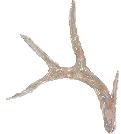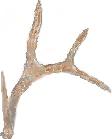Kerr WMA: Deer Research Projects
Spike vs. Fork Antlered Yearlings: 1974-1994 (144 deer), (Ott 1985-1990)


In this study, antler production of fork-antlered yearlings and spike-antlered yearlings were compared annually until 4 years of age. Fork-antlered deer produced almost twice the antler mass each year as their spike-antlered counterpart. Results of this study are also published in the 1989 Texas Parks and Wildlife bulletin Effects of Genetics and Nutrition on Antler Development and Body Size of White-tailed Deer (PDF 945 KB) This study has been complimented and updated since 1985 by Dr. James Ott and R W. Scott and data presented at both the Texas Chapter of the Wildlife Society and the 1997 Southeast Deer Study Group entitled, Comparative Antler Characteristics of Spike and Fork-Antlered Yearling White-tailed Deer in Texas at 4.5 Years.
(PDF 945 KB) This study has been complimented and updated since 1985 by Dr. James Ott and R W. Scott and data presented at both the Texas Chapter of the Wildlife Society and the 1997 Southeast Deer Study Group entitled, Comparative Antler Characteristics of Spike and Fork-Antlered Yearling White-tailed Deer in Texas at 4.5 Years.
Another related study compared antler production under field conditions of deer that were spike or fork antlered as yearlings. This study was conducted in a 96-acre deer-proof pasture over a four year period. Deer were "range grown" without supplemental feed. Although small sample size prevented the two groups of deer from being statistically different, trend data indicated that antler production of fork-antlered deer surpassed that of spike-antlered deer. Results of this study are reported in Federal Aid Performance Report W-109-R Job 38: The Effects of Genetics on Antler Development and Body Size Under Field Conditions.